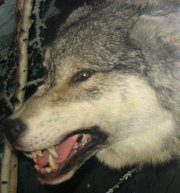Wolf
The Gray Wolf (Canis lupus; other forms: "Timber Wolf", "Wolf") is a mammal of the Canidae family. more...
The wolf shares a common ancestry with the domestic dog (Canis familiaris), and, according to most experts, is likely the progenitor of dogs as they exist today (in which case, the domestic dog would more accurately be classified as C. lupus familiaris). Gray wolves were once abundant and distributed over much of North America, Eurasia, and the Middle East. Today, for a variety of human-caused reasons involving widespread habitat destruction and excessive hunting, wolves inhabit only a limited portion of their former range.
Gray wolves, being keystone predators, are integral components of the ecosystems to which they typically belong. A list of potential wolf habitat reflects their adaptability as a species, and includes temperate forests, mountains, tundra, taiga, and grasslands. In the contiguous U.S., with the exception of Minnesota, they are listed as endangered under the Endangered Species Act of 1973 (in Minnesota, they maintain a threatened status). They continue to be hunted in many areas of the world as perceived threats to livestock and human well-being, as well as for sport.
Carolus Linnaeus gave the wolf the scientific name Canis lupus in the 18th century.
Anatomy & Physiology
Wolf weight and size tend to increase proportionally with worldly latitude, with height varying between 0.6 and 0.9 meters (23.6 to 35.4 inches) at the shoulder, and weight typically ranging from 30–55kg (66-121 pounds), making wolves the largest among all wild canids. Males average about 45kg (100 pounds), while females, generally speaking, weigh around twenty percent less. Extremes have been recorded from 20-80kg (44-176 pounds). Wolves measure between 1 and 1.5 meters (39-59 inches) from nose to tail tip, with the tail itself consisting of approximately one quarter of overall body length.
Wolves are built for stamina, possessing features tailored for long-distance travel. Narrow chests and powerful backs and legs contribute to the wolf's proficiency for efficient locomotion. They are capable of covering several miles trotting at about a 10km/h (6.2mph) pace, though they have been known to reach speeds approaching 65km/h (40mph) during a chase (wolves only run fast when testing potential prey). While sprinting thus, wolves can cover up to 4.9m (16ft) per bound.
Wolf paws are designed to traverse easily through snow, giving wolves an advantage over hampered prey. Wolves are digitigrade, and so the relative largeness of their feet helps to better distribute their weight on snowy surfaces. The front paws are larger than the hind paws, and feature a fifth digit, a dewclaw, that is absent on hind paws. Bristled hairs and blunt claws enhance grip on slippery surfaces, and special blood vessels keep paw pads from freezing. Furthermore, scent glands between a wolf's toes help it to keep track of its location, and others of its whereabouts.
Read more at Wikipedia.org




